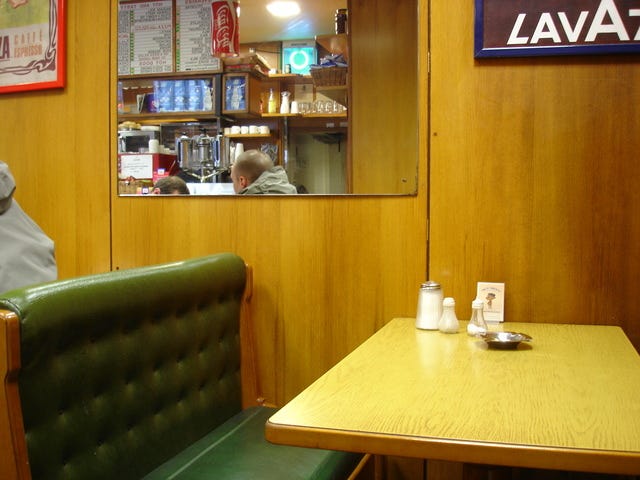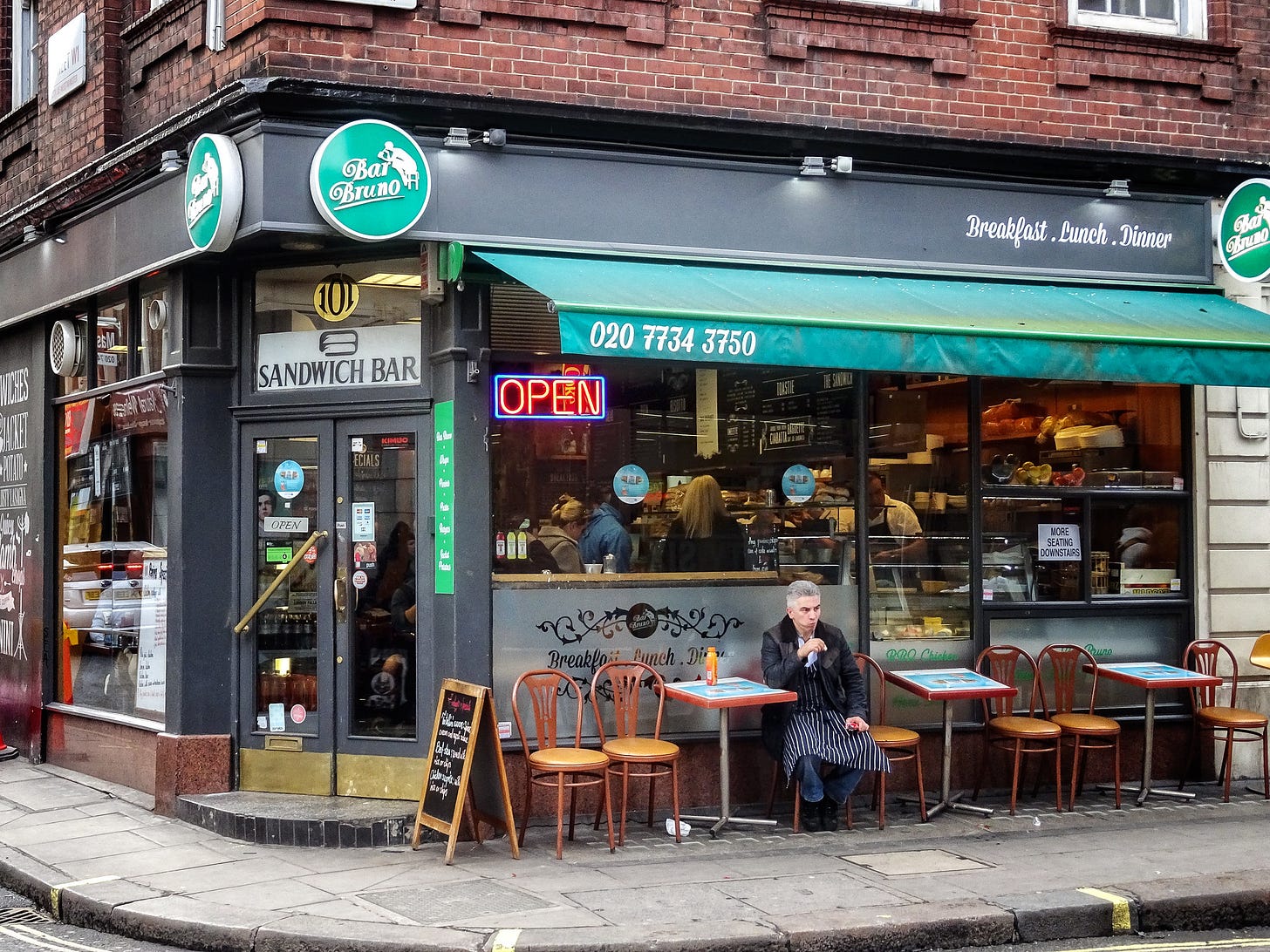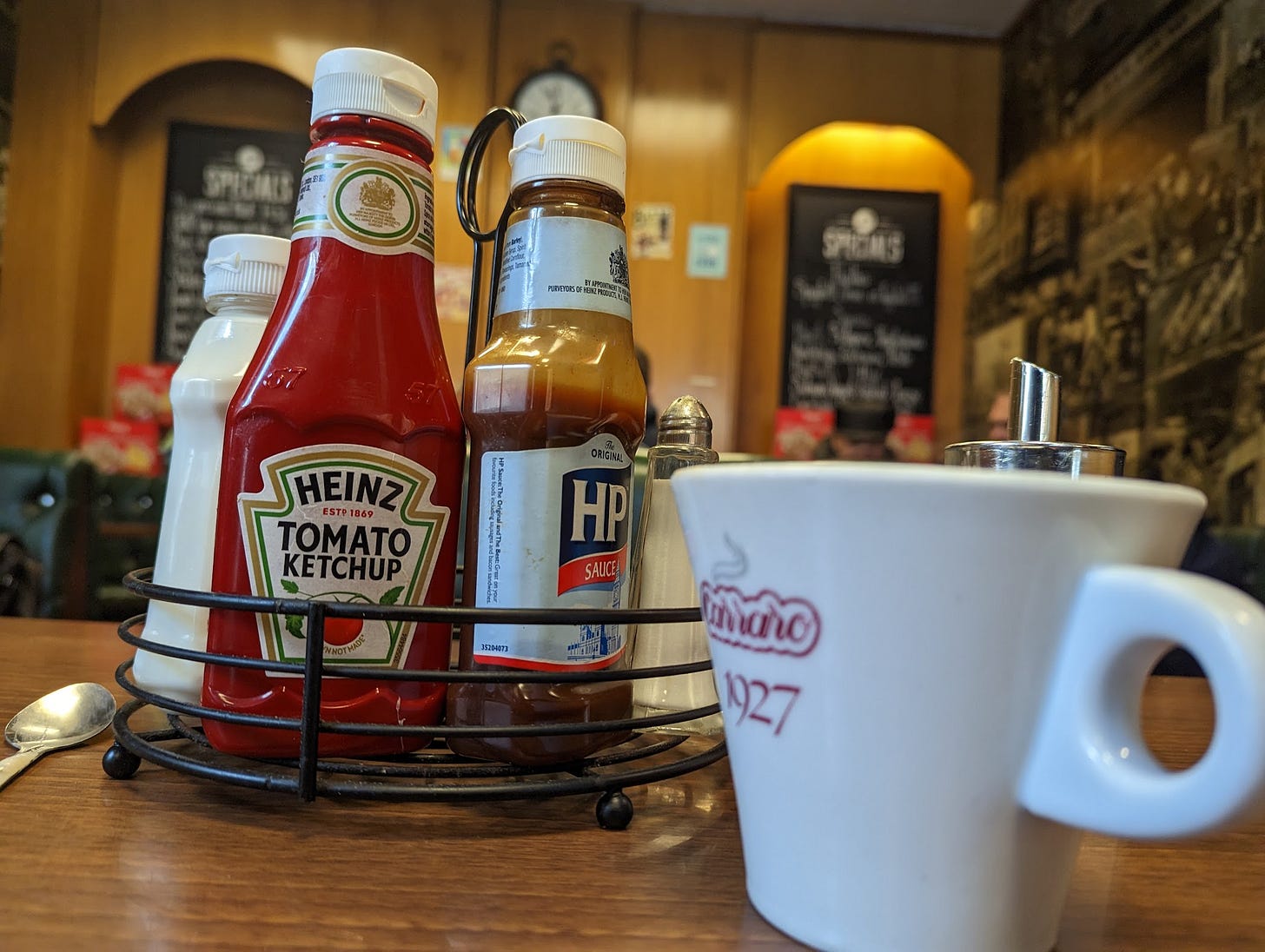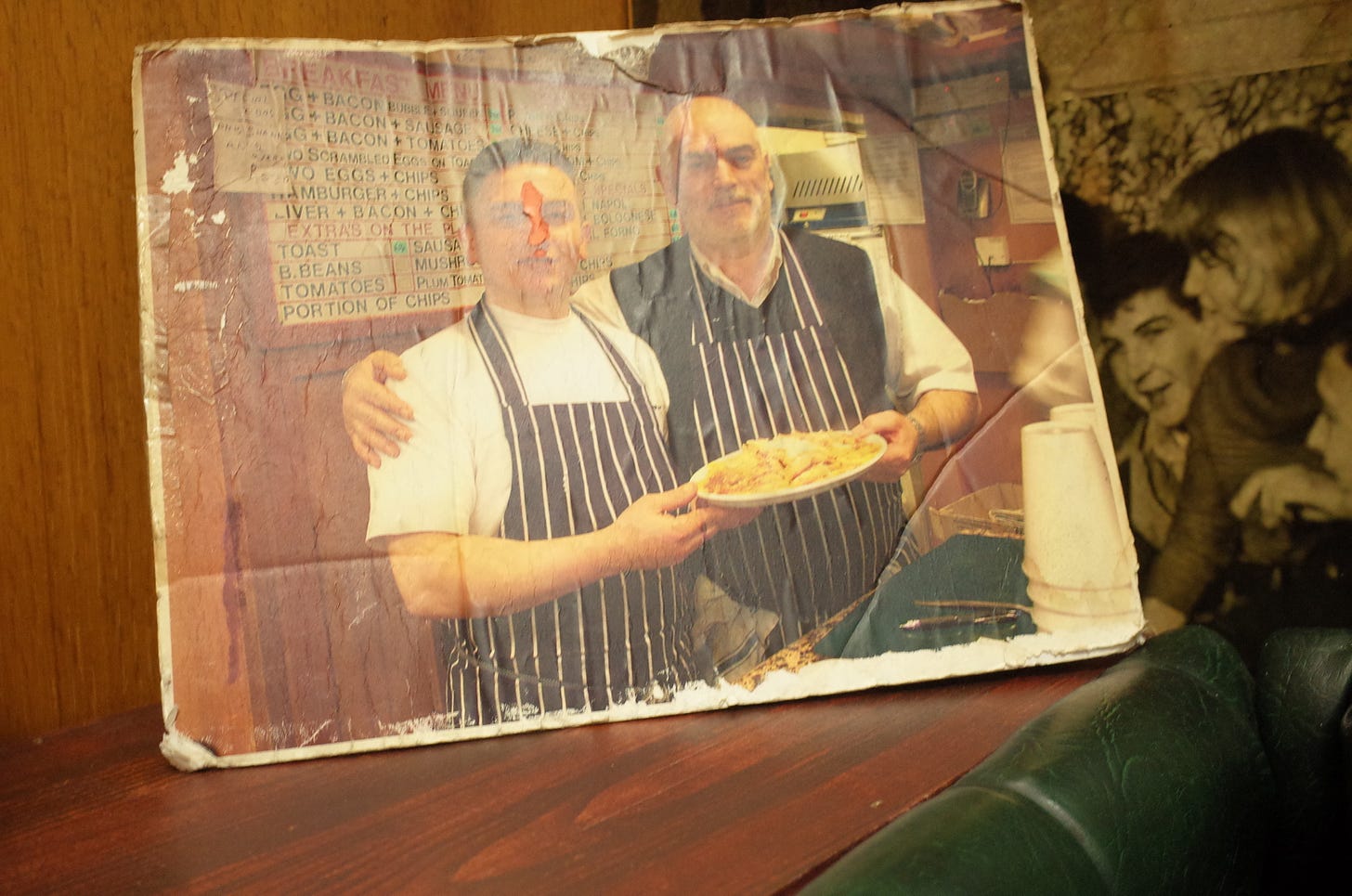At the start of April we published a special contributor issue about one of our favourite Soho bars, and it very quickly became the most read and shared edition of LiB we’ve ever put out:
We were very happy about that for two reasons. Firstly, we love Bradley’s; and if only a few of the people who read that issue went and spent a few quid there, then we’ve done our bit. Second, that issue was intended to kickstart a whole series on London’s most loved but potentially endangered places; and your response confirmed to us that might be something you wanted to read about.
So here is the first proper installment in the series we’re calling ‘Before You Go’. With each of these issues we’re going to invite someone we like and whose opinion we trust, to pick one spot that they absolutely adore but that might be at greater risk at disappearing than it was a few years ago.
It might be a small family-owned restaurant, a backstreet pub, or a community garden… Any kind of place of which there are far fewer of these days. The idea is to go and visit the place with its ‘champion’ and talk about what makes it so special: the people, the food, the drinks, the atmosphere, the decor, the history… And in doing so maybe we can tempt a few people along to visit it for the first time or to go back and reacquaint themselves with an old favourite.
For the first edition of ‘Before You Go’ we're back in Soho…
Bar Bruno on Wardour Street, with Russell Davies

P.S. If you want the full immersive experience, then get your headphones and press play on this 10-minute recording of Bar Bruno ambience:
Even if you’re looking for Bar Bruno, it’s still quite easy to walk right past it.
In the midst of an increasingly boorish Soho streetscape littered with immersive window displays and punny chalkboards, Bruno’s is almost aggressively stoic. It’s only nudge towards showiness being the red neon sign declaring that there is ‘More seating downstairs’ and the smart, bottle green awning that leans out rakishly into Wardour Street (the awning doesn’t even contain the name - just a phone number).
But the real anonymity of Bruno’s comes from its familiarity. It has been there, nestling the corner of Wardour Street and Peter Street at the tail end of Soho, since the 60s; and while it has changed (both inside and out) over the decades, it has never been tempted to mar its beauty through overly-aggressive surgery. Instead, it has steadily seasoned; soaking up the Soho-ness that surrounds it to form a particular and charming veneer that is more classic than traditional and more archetypal than chintzy.
Patina of sadness

We are here to meet Russell Davies, who we’ve known as long as we’ve been messing about with words on the Internet. Russell began blogging in 2003, and he hasn’t stopped for the last twenty years. In that time, he’s also created the Interesting Conference (one of our favourite annual, London events), cofounded Newspaper Club been a Contributing Editor for Wired magazine and had his work featured at the Museum of Modern Art in New York and the Royal Academy Summer Exhibition.
More importantly (for our purposes, at least) in 2005 Russell wrote Egg, Bacon, Chips and Beans: 50 Great Cafes and the stuff that makes them great, a book based on his brilliant series of blog posts, that came about - as Russell tells it - simply because he couldn’t think of anything else to write about.
“The blog came from wanting something to blog about,” Davies says with a smile as he settles into a booth in the basement room of Bar Bruno (it’s quieter down here and there’s less stress on the Dictaphone). “Although the name came from being in a band at the end of the 80s and driving to London to do gigs. Driving back to Derby we’d stop at Leicester Forest East services, which did egg, bacon, chips and beans and that became what I always ordered. When I moved to London we’d go on a night out but, partly because I don’t drink, we’d end up at Wimpy’s by Piccadilly Circus, and then we found the New Piccadilly Cafe. When you didn’t want to end up in a pub, a caff was the place to be.”
Perhaps because cafes were an alternative to pubs for Davies, it was never the nostalgia or the ‘doomed romance’ of London’s cafes that attracted him. He was more drawn to the to the vitality and the energy of the places.
“I liked some of the really good cafe books that were out at the time, like Adrian Maddox’s Classic Cafes,” Davies says as he starts in on a bacon sandwich on white bread (his regular order now he can’t eat EBCB quite as often), “but the type of cafes in those books were largely places that were just about to go out of business. There is something attractive about a place that’s empty and quiet, where everything is a bit worn and there’s that patina of sadness. But you can’t complain if somewhere goes out of business if part of the reason you were really attracted to it was because it was just about to go out of business! I get that there’s an attractive sort of vibe to faded glamour, but I like places that are alive.”
Davies cites the much-missed Farina’s that used to stand on Leather Lane as a prime example. “Farina’s was magnificent,” he exclaims. “It looked like Bill Nighy might walk in at any moment and there’d be sad violin music playing. It was so atmospheric, but you couldn’t help but wonder how it stayed alive. And then, of course, it closed and got turned into a third wave coffee place.”
Davies never took his cafe blogging too seriously, insisting that he was actually “never that interested in food” and definitely not a ‘food blogger’ (“I wrote about condiment clusters!” he protests), but his blog gave him a reason to seek out cafes and as he visited each one, he began to see what made them so special and why some were maybe more special than others.
“I never gave them star rating or things like that,” he says, “and the write ups were probably never more than about 50 words, or whatever it took for me to find another ridiculous metaphor for what the eggs looked like. But I never said anything bad about any of them, because what would be the point? In fact, one of the things I like about this kind of food is that it’s hard to get wrong. You can be on any street and go into the caff and it will probably be fine, and it might even be better than that. I like that interchangeability. Take Pellicci’s for example. It’s obviously fantastic, but it’s like a National Trust property. It’s a ‘thing’. Whereas I like places that could be anywhere.”
Accumulated cruft
Surely though, there are some things that set the great cafes apart from the rest?
“Well, almost everywhere is odd after you’ve been more than a handful of times,” Davies says, gesturing around him to Bruno’s basement wall, which is covered with a huge mural depicting Soho through the ages.
“You get the odd ordering conventions that you’re expected to know. Do we order here? Can we sit there? When do we pay? I love all that stuff. And when you begin to recognise those idiosyncrasies, then you become attached to them. Here is great because they’ll let you sit with a cup of tea for quite a long time. They know their audience, so they won’t hassle you. If you spend that time looking around you, then you will be rewarded.
“For example, the photo montage they have on the wall upstairs is full of these old Soho scenes and in the middle of it there’s a photo of the aftermath of the Admiral Duncan bombing. It looks like it was taken about 30 seconds after it happened. It’s quite disconcerting, but I suspect it’s because they got a designer to do a photo montage and that person Googled ‘things that happened in Soho’. It’s either that or a really strange tribute to the bombing.”
Davies call this the “accumulated cruft of stuff” that every cafe gradually acquires once it’s been around for a few years. It’s his theory that, not only is the careful curation of this cruft essential to creating a place people want to come back to, but that the quickest way to kill an ‘institution’ like Bar Bruno is to try and preserve it in aspic.
“Bar Bruno is great because they’re very energetic here,” he says, “so they keep updating the place and adding new stuff to the menu. Your classic cafe bloggers and the people who love the faded Formica might grumble, but the good places change all the time. Instagrammers might not like it when somewhere puts new seats in, but people like clean seats! Look at Marie’s Cafe on Lower Marsh, that’s basically a Thai place with fry ups now. That’s how you keep going. Not by being a preservation society.”
Bar Bruno might have had the odd lick of paint and menu refreshes, but that can’t be the only reason it’s been able to become the only remaining ‘greasy spoon’ in Soho. There must be some other secret ingredients that have contributed to its longevity.
“Well, for a start,” says Russell, warming to his theme a little, “the food is better than it needs to be. It’s not like a terrible transport caff or something. But they’ve also got different constituencies of customer. If you sit here all day - as I have done occasionally - then you’ll see it starts off with the builders. If you talk to cafe owners, you’ll find a lot of them are dependent on whatever the big, local building project is, and Crossrail has been a huge help for this place. After the Crossrail people, you’d see all the runners from the production companies coming in and getting 20 coffees. Then, at the weekend, you’d see all the people ejected from the Supreme queue. That window seat where the Supreme queue is makes for brilliant people watching on a Saturday or Sunday. Because you see all the tourists going ‘Ooh there’s a Supreme shop, let’s go in there’ and then… Nope!”.
Cautious optimism
There does seem to be a bit of a renaissance in cafe appreciation happening right now. With Jonathan Nunn never missing a chance to proclaim his love of a doorstep chicken escalope sandwich (preferably from brilliant HT Harris on Great Titchfield Street) and, more recently, Isaac Rangaswami’s Caffs not Cafe’s making fixed seating and Formica cool again.
“Isaac is fantastic and puts way more energy into it than I ever did,” laughs Davies, “he’s even been kind enough to say he liked my book. I love that there are people being enthusiastic about these places, but I do worry that it means that someone is ignoring the place on the next street, which is just as good but maybe doesn’t have quite that special patina. Or it has generic metal tables and one of those fake neon signs made out of little LED dots. Those places are also good!”
“I worry about the enormous queues outside The Breakfast Club,” Davies continues, “when the cafe on the corner, right next to the Breakfast Club, is empty. I’ve got nothing against The Breakfast Club, but it feels like that food bloggers and social media can create this idea that there’s only five good cafes in London. I love Scotti’s too, and Beppe’s is fantastic. They’re all good cafes. But there’s also probably going to be one that’s just as good on the street you live on.”
As we mop up the remnants of our lunch, the conversation turns to the elephant in the room. Could Bar Bruno ever really disappear?
“Nowhere is safe, especially right now,” Davies says, draining his mug of tea, “but I think the sadder fate than it closing down would be if they did a Pattiserie Valerie to it. It’s unlikely with this place, but you could maybe see it happening to a place like Maison Bertaux. Someone franchising it really badly and just ruining it. Patisserie Valerie used to be so good! It’s very weird to me why someone would kill it in that way.”
Russell is optimistic though, not just about Bar Bruno’s future, but the future of all local cafes. “If you’re someone that’s been going to Starbucks for the past ten years or so, and that Starbucks has just been replaced by a new, even more aggressively bland place like Blank Sreet Coffee,” he says with a grimace, “I think it’s inevitable that you might start to wonder about that place next door that’s been there all along. Maybe twenty years ago the coffee in there might have been terrible, but these days it’s probably a lot better. And at least it has some personality.”
As we wander upstairs to pay, Davies admits that, even though he and his partner have been coming to Bar Bruno for 30 years now, he has no idea what the names of the people who work here are. But that’s not wilful ignorance on his part. “They have no idea what our names are either!” he says with a smile. “They sort of recognise us, so if I turn up on my own someone might ask ‘Where's the lady?’ but that’s it. And that’s fantastic!”.
Russell’s latest book Everything I Know About Life I Learned From PowerPoint can be purchased here for the bargain price of £12.
This year’s Interesting Conference is on Wednesday 17 May. Tickets are on sale here.
5 little bits
This last weekend marked 30 years since Stephen Lawrence was murdered. On Saturday, Met Commissioner Mark Rowley said that black communities in London “feel over-policed and under-protected,” and that there are still “disproportionalities and systemic biases in our use of policing tactics and our support to victims of crime”. Meanwhile, on Friday the Guardian ran a long piece on how the Met continues to use “racial profiling and censorship [to] target Black music;” and on the same day it was reported that a Met officer “patrolling London’s nightclub district was bribed with a professional escort, a free foreign holiday for his family, bespoke suits, exclusive entertainment and a house renovation”.
Foxtons’ has been “boasting” about its 27% increase in revenue from lettings that was boosted by securing “longer non-cancellable terms” from tenants who are desperate to find somewhere to live. The director of the campaign group Generation Rent calls that “forcing tenants into longer fixed term tenancies or paying multiple months’ rent up front”. Meanwhile, The FT has a (paywalled) article on how “London’s parasitical housing market is driving away young families” and forcing primary schools to close.
The Times has been back on the trail of the secret Chinese police stations, including the one that’s allegedly in the office of a “food delivery firm” on Croydon High Street. That article is paywalled, but you can get a rundown of what’s going on, plus what happened when Croydon MP Sarah Jones asked an ‘urgent question’ about the issue in Commons last week, from Inside Croydon.
In ‘big art’ news, Damien Hirst’s 60ft ‘Demon with Bowl’ sculpture has gone up on the Greenwich Peninsula, while Southwark News has an update on whether Stompie the Tank will ever return.
This guy is building a map of places to get a drink in London after 11am, that aren’t clubs and are free to get in. 109 places on there so far. What a hero.







Typical ... I was 2 minutes from here this morning on record shop travels. Still, I know where to stop off next time.
The Palm Tree in Mile End deserves a similar write up - specifically their live music nights!